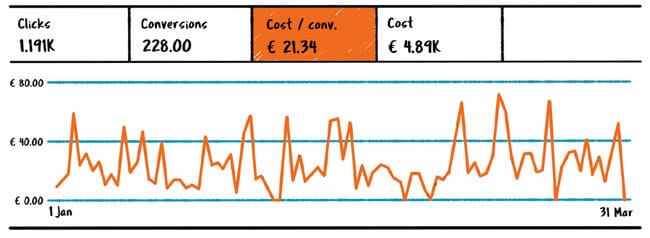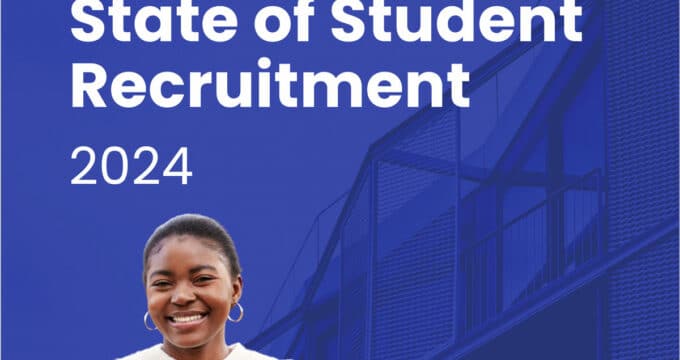Using Google Ads for international recruitment: Measuring results with key indicators
The following guest post is an advance excerpt from the forthcoming book “Successful student recruitment with Google Ads”. The author, Guus Goorts, is a digital marketing specialist based in the Netherlands and with a distinct focus on the international education sector. Please consult the author’s website for additional background and ordering information.
Having goals and objectives is great, but let’s face it: things often work out differently in the real world. Measure performance and you’ll be able to see what works and what doesn’t – and to double down on what works. Tracking performance helps to keep you on track to achieving your objectives. But what you measure will make a big difference.
To give you two hypothetical examples, analytics may tell you that
- students from Bulgaria are highly likely to successfully complete your bachelor of automotive engineering, and
- none of the leads that came in through your Instagram campaign actually applied for a programme.
The metrics you keep track of don’t only determine what you know: they also dictate what you and your team will prioritise.
The key metrics to keep track of in the context of Google search ads are:
- cost per lead (CPL),
- lead engagement,
- application rate,
- offers rate, offer take-up rate.
As you see, they follow the marketing funnel from initial exposure to offers taken up. I’ll now go on to cover each of them in more detail below.
Cost per lead (CPL)
What is it?
How much does it cost to generate one enquiry or brochure download?
How does the cost differ between
- channels (e.g. your SEA campaign vs. Facebook ads), and
- target groups (e.g. national students vs. students from Bulgaria)?
Why is it important?
CPL is a good metric for assessing the effectiveness of a campaign. It compares the “output” of a campaign to what it costs. There are high- and low-quality leads, but leads are much more meaningful than clicks. Those who make an enquiry (i.e. who become leads) have visited your website, read some content and taken action to further the relationship.
CPL is also an important building block for establishing your advertising budget. If you know (1) how many leads it takes to get an enrolment and (2) how much it costs to acquire one additional lead, then you can derive the budget required to reach your goal.
How do you calculate CPL?
Do this as follows:
CPL = (total campaign cost) ÷ (number of leads acquired)
Number of leads acquired. How many downloads, brochure requests, subscribers and/or enquiries did the campaign bring in? If all the traffic for a given campaign goes to a unique landing page or form, you can simply count the number of leads. If the campaign shares a form with other types of traffic, you’ll need to make sure that whenever a submission is made, the source is registered.
- Total cost of campaign. What do you spend to run the campaign? This figure should include the advertising costs paid to Google, Facebook or other platforms; and
- the cost of producing the creative, and the costs for copywriting and campaign management.
Automate it
When set up correctly, Google Ads can calculate CPL automatically and even give you the figures for specific keywords, landing pages and ad copies.

Terminology issues. What does the word “lead” mean in your organisation? Does it refer to someone who subscribes to email updates? Or do you use the term to refer to prospective students who show up on your open day? Either is fine, but don’t throw both numbers on the same stack as this would make the CPL figures meaningless. To avoid confusion, it’s better to ditch the term “lead” and refer to the specific item involved, for example “cost per open day visitor” or “cost per enquiry”.
Lead engagement
What is it?
Lead engagement is a measure of how active leads are after they are acquired. Individual organisations may define the term somewhat differently, but the metric will show up as a percentage of the total number of leads who took action after enquiring, for example, by attending an open day.
Why is it important?
When a lead engages further with you, he or she hits another milestone on the path to becoming one of your students. While it’s great to have lots of people on your mailing list, you want as many of them as possible to take the next step.
If lead engagement is low, it may mean you didn’t acquire the right kinds of leads to start with or that you haven’t paid enough attention to following up with them. While every situation is different, I’d pay serious attention if lead engagement falls below 30%.
How do you calculate lead engagement?
It can be calculated as follows:
Lead engagement = (leads that took a specified action) ÷ (total number of leads)
If you have a CRM set up, it may report the figure automatically on a dashboard. But you can also calculate it manually, once or a few times a year. To do this, count the total number of consequent actions (e.g. RSVPs for open days) in a period and divide this number by the number of leads acquired in that same period.
Application rate
What is it?
The percentage of leads that submit a valid application.
Why is it important?
Applying is the natural next step on the path to becoming a student. You will want to know if a good percentage of the people who enquired and were in touch with you actually ended up applying for the course. If this figure is low, it may point to a problem in the preceding steps. The sooner you find out there is a problem, the sooner you can fix it. It’s that simple.
How do you calculate it?
Application rate is calculated by dividing the yearly number of applications by the number of leads:
Application rate = (number of applications) ÷ (number of leads)
Again, depending on your set-up, this number can be calculated either automatically or manually.
Offer rate
What is it?
The offer rate is the percentage of applications that are accepted.
Why is it important?
Especially if your institution is competitive to get into, this number can give you a good idea of the quality of applicants that the different campaigns manage to attract. If certain campaigns bring in lots of applications but very few of these applications get accepted, it may mean that the campaign was aimed at the wrong demographic or that expectations were unrealistic.
How do you calculate it?
The number of offers given can be calculated as follows:
Offer rate = (offers given) ÷ (applications received)
Offer take-up rate
What is it?
The percentage of the total number of offers given out that are actually accepted.
Why is it important?
Just because you extend an offer doesn’t mean that you’ve got yourself a new student. Prospective students may apply to multiple institutions. If there is a large gap between offers extended and students starting the programme, you may need to do a better job of staying in touch with offer holders and getting them started. Also, this gap may point to something that puts you at a disadvantage compared to competing institutions. Perhaps they offer better facilities or more prestige. It can also have to do with how your offer was communicated and whether the offer holder was reassured in the period between offer and decision.
How do you calculate it?
You can calculate the offer take-up rate as follows:
Offer take-up rate = (offers accepted) ÷ (offers given)
Conclusion
Recruiting students for a programme is a process. To know whether the process is working well and to identify possible bottlenecks, you need to keep an eye on a number of KPIs along the way:
- cost per lead,
- lead engagement,
- application rate,
- offers given,
- offer take-up rate.















